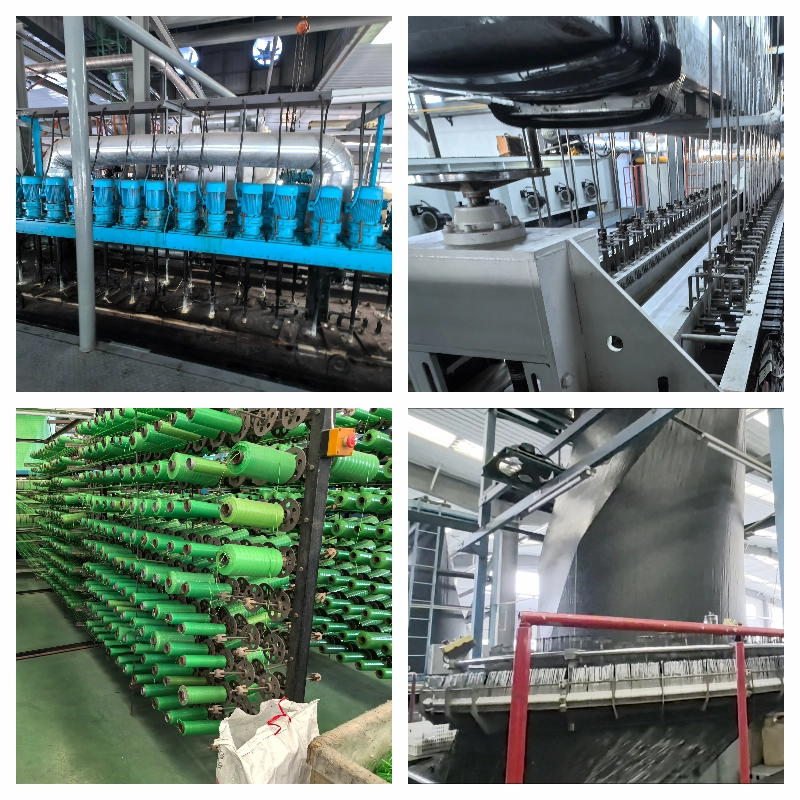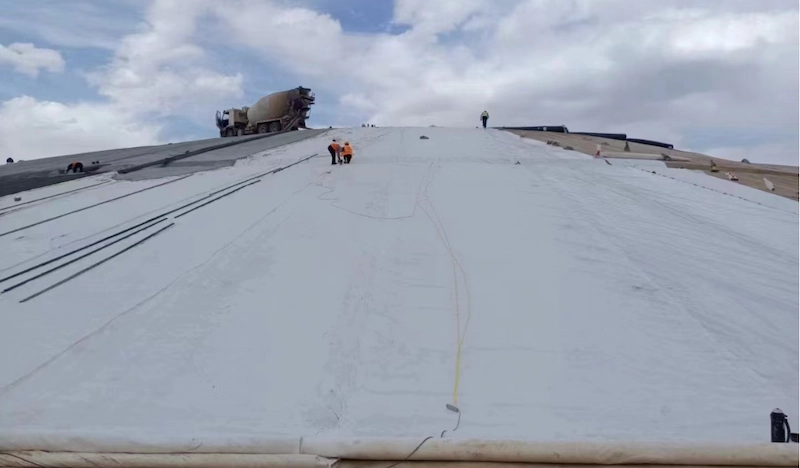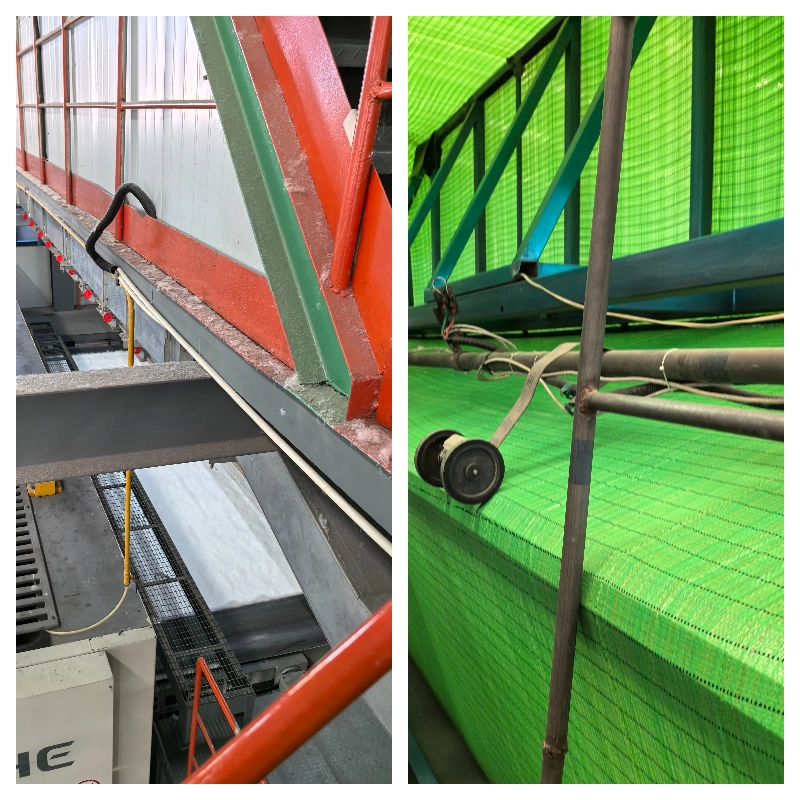by Lucia-Haoyang Environment
In the realm of civil engineering, geotextiles play a crucial role in enhancing the stability, durability, and performance of various structures. These two geotextiles have their own advantages. This article aims to make a simple comparison of their definition, advantages and disadvantages, application fields and so on, and to give a reminder of the matters needing attention during construction
I. Definitions
Woven Geotextile:
Woven geotextiles are produced by weaving synthetic fibers such as polypropylene, polyester, nylon, or vinyl into a fabric. This process involves interlacing warp and weft threads at right angles to each other, creating a strong, durable fabric with a defined pattern.
Non-woven Geotextile:
Non-woven geotextiles, on the other hand, are manufactured without the traditional weaving or knitting process. They are formed by bonding fibers together mechanically, thermally, or chemically. This results in a fabric that is often softer, more flexible, and has a random fiber orientation.
937396.webp)
II. Difference of Raw Materials and Production Processes
1. Raw Materials:
Woven Geotextile:
l Raw Materials: Synthetic fibers like polyester, polypropylene, nylon.
l Characteristics: Woven geotextiles are produced by interlacing yarns perpendicular to each other in a warp and weft configuration, similar to traditional fabric weaving.
Non-woven Geotextile:
l Raw Materials: Short staple fibers or continuous filaments of polyester, polypropylene, or other synthetic materials.
l Characteristics: Non-woven geotextiles are made from staple fibers or continuous filaments that are bonded together without weaving or knitting.
2. Production Processes
Woven Geotextile:
(1) Yarn Preparation: Yarn is spun, drawn, and sometimes textured to achieve desired properties.
(2) Weaving: Yarn is fed onto the loom, where it is interlaced to form the woven fabric.
(3) Finishing: The woven fabric may be heat-set, calendered, or coated to improve durability and performance.
(4) Optional Treatments: Additional treatments like UV stabilization, flame retardancy, or chemical resistance may be applied.
Non-woven Geotextile:
(1) Fiber Preparation: Fibers are cleaned, blended, and sometimes cut to a desired length.
(2) Web Formation: Fibers are laid down in a random or oriented manner to form a web.
(3) Bonding: The web is then bonded together using various methods such as:
l Chemical Bonding: Adhesives or binders are applied and then cured.
l Thermal Bonding: Fibers are heated to melt and bond at their crossover points (e.g., bicomponent fibers).
l Mechanical Bonding: Needle punching or hydroentanglement is used to entangle fibers.
(4) Finishing: The bonded web may undergo treatments such as calendaring, coating, or embossing to enhance its properties.

III. Comparison of Physical, Mechanical, and Durability Properties
Woven Geotextile:
l Advantages: High tensile strength, dimensional stability, resistance to tearing and abrasion.
l Disadvantages: Less flexible, heavier, and may have limited conformability to irregular surfaces.
Non-woven Geotextile:
l Advantages: Excellent flexibility, lighter weight, better conformability to irregular surfaces, high porosity for drainage and filtration.
l Disadvantages: Lower tensile strength compared to woven, may have limited resistance to puncturing and tearing in certain applications.
1. Physical Properties:
Property/Characteristic | Non-woven Geotextile | Woven Geotextile |
Fiber Composition | Various lengths of synthetic or natural fibers | Continuous longitudinal and latitudinal fibers |
Structure | Open, fibrous network | Tightly woven fabric |
Density | Can vary, typically moderate to high | Can vary, but often denser than non-woven |
2. Mechanical Properties:
Property/Characteristic | Non-woven Geotextile | Woven Geotextile |
Tensile Strength | Moderate to high, dependent on fiber type and production method | High, due to continuous fiber structure |
Elongation at Break | Varies, generally good | Varies, but typically lower than non-woven due to rigid structure |
Puncture Resistance | Moderate to high, depending on fiber density and bonding method | High, due to tight weave |
3. Hydraulic Properties:
Property/Characteristic | Non-woven Geotextile | Woven Geotextile |
Water Permeability | Excellent, due to open structure | Poor to moderate, depending on weave density |
Filtration Efficiency | Good to excellent, depending on fiber size and structure | Moderate to good, depending on pore size |
4. Durability:
Property/Characteristic | Non-woven Geotextile | Woven Geotextile |
Weather Resistance | Good, depending on fiber type and UV stabilization | Good, but may degrade faster in UV light without proper protection |
Chemical Resistance | Excellent, due to high-molecular material composition | Moderate to good, depending on fiber type |
Abrasion Resistance | Moderate to high, depending on fiber type and surface treatment | High, due to tight weave and fiber durability |
5. Other Properties:
l Flexibility: Non-woven geotextiles are highly flexible due to their open, fibrous structure. Woven geotextiles have lower flexibility due to their tight weave and rigid structure.
l Weight: Non-woven geotextiles are typically lightweight, depending on fiber type and density. Woven geotextiles can vary in weight, but they are often heavier than non-woven due to their dense structure.
l Cost: Non-woven geotextiles are typically lower in cost than woven geotextiles due to their simpler production process. Woven geotextiles have a higher cost due to their more complex production process.
IV. Applications
Applications | Woven Geotextiles | Non-woven Geotextiles |
Road Construction | Used as reinforcement to prevent subgrade settlement and increase pavement durability. | Used for drainage and separation of aggregate layers, enhancing road stability. |
Water Management | Suitable for lining canals and reservoirs due to high tensile strength and durability. | Effective in filtration and drainage systems, preventing soil particles from clogging drainage channels. |
Slope Stabilization | Used in soil retention structures and slope protection to prevent erosion and landslides. | Provide soil reinforcement and erosion control, especially in areas prone to heavy rainfall. |
Environmental Engineering | Applied in landfill liners and waste containment systems for high-strength barrier protection. | Used in separation and drainage layers in landfills, preventing leachate migration. |
Agriculture | Less common due to cost and durability considerations. | Widely used as mulching material to retain soil moisture, suppress weeds, and protect soil from erosion. |
734692.webp)
V. Selection in Engineering Design
Haoyang participated in the construction of the South-to-North Water Diversion Middle Route Project, the Three Rivers Management Project, the Daxi Railway, the Central-South Channel and other national key water conservancy and transportation projects; it undertook a large number of environmental pollution control and hazardous waste treatment and disposal projects such as the "Alumina Red Mud Storage Environment Management Project" of Shandong Weiqiao Group, the "Gold Mine Tailings Reservoir Expansion Project Anti-seepage Project" of Yunnan Heqing Beiya Mining Co., Ltd., the "Phase I Project of Phosphogypsum Slag Reservoir" of Sinochem Yunlong Co., Ltd., the "Lunjingtang Phosphogypsum Slag Field Project" of Hubei Xiangyun Chemical Co., Ltd., and the "Reuse Water Device Evaporation Pond Project" of Inner Mongolia Zhongmei Mengda New Energy Chemical Co., Ltd. We have achieved good results in project design & construction and gained rich experience
When choosing between woven and non-woven geotextiles, engineers could consider the following factors:
1. Tensile Strength:
l Woven Geotextiles: Typically have higher tensile strength due to their woven construction, making them suitable for applications requiring structural reinforcement.
l Non-woven Geotextiles: Generally have lower tensile strength but better flexibility and conformability, making them ideal for drainage and filtration applications.
2. Durability:
l Woven Geotextiles: More durable and resistant to wear and tear, suitable for long-term applications in harsh environments.
l Non-woven Geotextiles: Less durable but cost-effective for short-term or temporary applications.
3. Permeability:
l Woven Geotextiles: Have varying permeability depending on weave pattern and yarn type, suitable for controlled drainage applications.
l Non-woven Geotextiles: Typically more permeable due to their open structure, making them excellent for drainage and filtration.
4. Cost:
l Woven Geotextiles: Generally more expensive due to their complex manufacturing process and higher material costs.
l Non-woven Geotextiles: More affordable, making them suitable for budget-conscious projects.
VI. Construction Considerations
Installation Tips:
1. Material Selection: Start by conducting a thorough soil analysis to determine the most compatible geotextile type. Consider factors such as soil type, anticipated loads, and environmental conditions.
2. Site Preparation: Prior to installation, prepare the site by removing debris, leveling the surface, and ensuring the ground is stable and free of contamination.
3. Weather Conditions: Avoid installation in windy conditions as both types of geotextiles can be easily displaced.
4. Method of Joining: Woven geotextiles may require stitching or welding, while non-woven materials can often be overlapped and secured with pins or stakes. For both non-woven and woven geotextiles, accurate placement is crucial. Use appropriate tools and machinery to lay the material evenly, ensuring seams are securely fastened—whether through welding for non-wovens or robust stitching/seaming for woven materials. Pay special attention to transitions and overlap zones to maintain continuity and strength.
5. Quality Control: Implement rigorous quality control measures throughout the installation process. This includes conducting on-site soil and geotextile testing, maintaining detailed construction records, and performing regular inspections to verify the integrity of seams, material thickness, and overall installation quality.
6. Environmental and Safety Considerations: Adhere to environmental protection protocols during and after installation to minimize ecological impact. Ensure all personnel are trained in safety procedures and wear appropriate protective equipment.
Maintenance:
1. Regular inspections are crucial to identify and repair any damage promptly.
2. Ensure that the geotextile remains covered or protected from direct sunlight and UV exposure to prolong its lifespan.

VII. Conclusion
In conclusion, both non-woven and woven geotextiles offer unique advantages tailored to specific engineering needs. By understanding their properties, applications, and installation considerations, Environmental and Safety Considerations: Adhere to environmental protection protocols during and after installation to minimize ecological impact. Ensure all personnel are trained in safety procedures and wear appropriate protective equipment.
Haoyang Company guarantees the product quality of Haoyang brand geotextiles with correct and high-quality raw and auxiliary materials, suitable production equipment, complete laboratories, and a complete quality assurance system. Whether you're working on a new project or upgrading existing infrastructure, our expert team is here to provide you with the best solutions tailored to your requirements. Contact us to discuss your needs and discover how Haoyang can help you achieve your environmental and engineering goals.

455.webp)
606.webp)
834.webp)